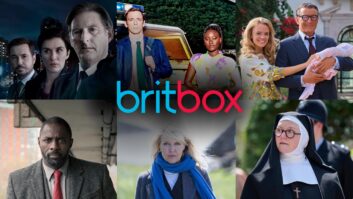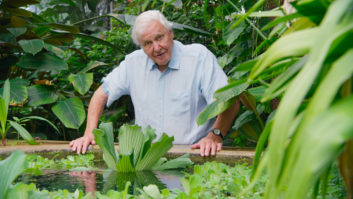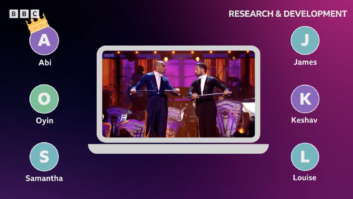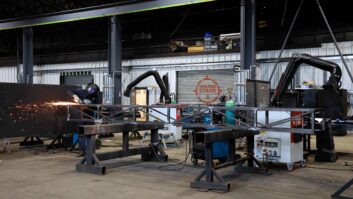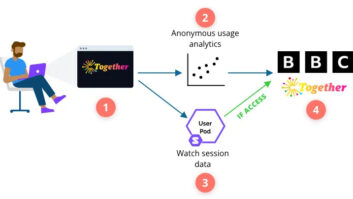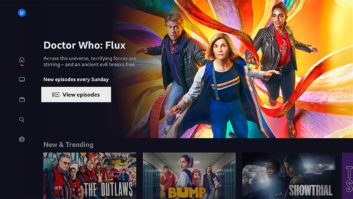The Open is one of BBC Outside Broadcasts’ biggest and most complex operations. Starting today, BBC1 and 2 will show 42 hours of live golf, plus evening highlights. Ensuring that the best coverage possible reaches the armchair golf fan is a Herculean task, requiring considerable innovation, writes Andy Stout.
A huge amount of planning goes into covering the Open, which starts today at Carnoustie, near Dundee. So much so that Paul Davies, Sport Editor at BBC Sport, has already visited Birkdale, the venue of the 2008 Open, to start work on next year’s coverage. “If you can go in with as many ‘favourables’ as possible, you stand a good chance of coming out the other end with a quality production. If you’re battling technically – pictures are breaking up or there’ s no sound – it’ s more about survival than painting the best picture of the Open, which is what we’re trying to do at the production end,” he commented.
BBC Outside Broadcasts, a division of BBC Resources, builds the infrastructure and televises the Open. Scaffold rigging starts at the end of June, more than three weeks before a ball is hit in anger. Next, the first portacabins and offices arrive on site. Most of the OB units come later from Wimbledon, the Scottish Open at Loch Lomond and the Sheffield athletics grand prix.
100 miles of cable are laid around the links course by the Saturday before the Open tees off. The technical rig continues on Monday and Tuesday, by which time four large OB units, three VT trucks, four satellite uplink vehicles, a graphics truck and the mobile presentation studio will have arrived, ready for a full-scale rehearsal on Wednesday.
The studio was first used at Hoylake last year to mark the arrival of new presenter Gary Lineker. “The mobile studio offers a cost-effective means of delivering a consistent presentational look to a show. The other way of doing it normally involves a hefty scaffold rig and that’s expensive,’ explains BBC Outside Broadcasts Head of Commercial, Phil Aspden.
There is no leeway if anything goes wrong as BBC TV coverage starts on Thursday at nine in the morning. Andy James is responsible for bringing the familiar sounds of the Open – the thwack of club on ball and the roar of the crowd – to the viewer. The Senior Sound Supervisor made his Open debut in 1999, the last time the championship was held at Carnoustie. Golfers dubbed the links ‘Carnasty’ as tough course conditions and awful weather sent scores spiralling.
“The physical elements are a big challenge because you’ve got to keep microphones working in pouring rain and howling gales,” said James. “When I watch golf from America and there’s not a breath of wind and it’s always sunny, it makes me long to work over there.”
James will be capturing sound from fixed microphones on the greens and teas, and from a mobile team of sound operators roaming the course with radio mics. It is a huge operation, requiring a sound team almost three times larger than a run-of-the-mill golf event.
Over the past seven years, says James, sound has moved entirely to stereo. But TV technology never stands still: 5.1 surround sound is just around the corner. Technology, though, is only a means to the end, which is providing the best coverage for the viewer.
“Our aim is to bring the excitement and atmosphere of the tournament to the viewer by getting in close to the action. Using radio mics and the better onboard sound you now get from cameras means that you can hear the players chatting when they’re walking down the fairways. That adds another dimension to the coverage.”
Camera Supervisor Jon Fay, who has missed just two Opens in two decades, is in charge of 60-odd cameras and has lots of fancy equipment at his fingertips. The Segway Cam, which tracks players and provides close-up shots as they walk the fairways, is a wireless Steadicam mounted on a Segway scooter. The operator shoots with the camera while steering the Segway with his knees. This clever piece of kit made its Open debut at Hoylake.
“It’s been specially adapted for broadcast use and gives you fantastic, steady shots. The Segway can get to within 10 feet of the player and, because it’s such a new device, the camera operators get a lot of interaction with the players,” says Fay.
Before the first ball is struck at Carnoustie, Fay will already have helicopter shots of each hole in the can to help the BBC pundits explain how the course should be played. Over the four days of the tournament, a remote camera attached to a blimp will offer live overhead shots.
Back on ground level, a Jimmy jib will follow the ball into the hole on the 18th. Another jib, mounted on a buggy, will hare around the course to take the viewer to the best of the action.
Communications Supervisor Martin Sexton, whose job is to provide non-cabled vision and audio feeds, makes his Open debut at Carnoustie. On the course, he supervises eight radio cameras, six of which are accompanied by mobile mid-point buggies to direct the sound and pictures back to three fixed receive sites on the course.
‘We need the buggies because, depending where the ball goes, the cameraman can’t always see a receiver and you need line of sight for radio cameras to work,’ explained Sexton.
“Links courses like Carnoustie are actually easier than ones like Wentworth, which are narrow and tree-lined. With a links, by using a 40-metre hoist you can see most of the course even with big sand dunes, but there’s still places where the camera can get out of sight. The cameramen can use the midpoint buggies to bounce the signal off to the receivers.”
BBC Sport’s Davies sums up what TV can do: “It’s about taking people to the event. It’s great when you hear people say, “I like going to Wimbledon or the Open, but there’s no better place than watching it on television.” That’s because you’re giving them great core coverage, but you’re also giving them great commentators, an insight behind the scenes and reaction to stories.’

